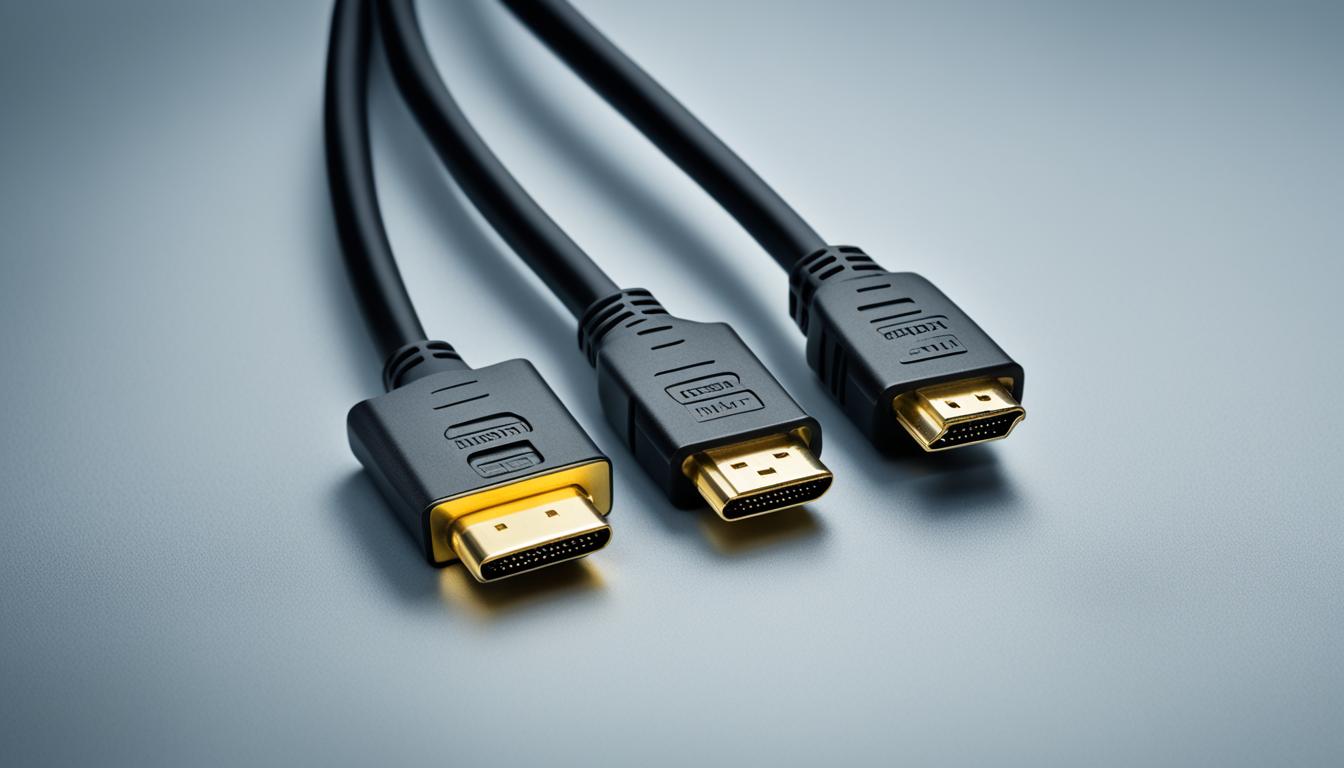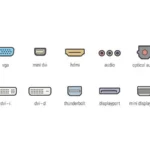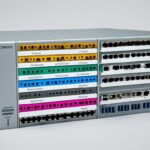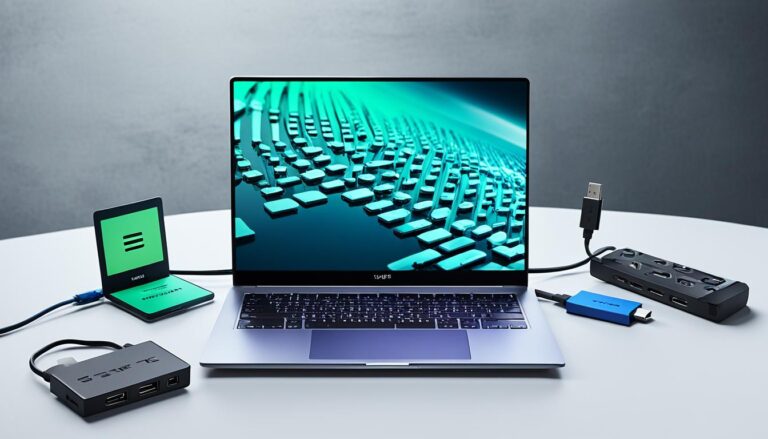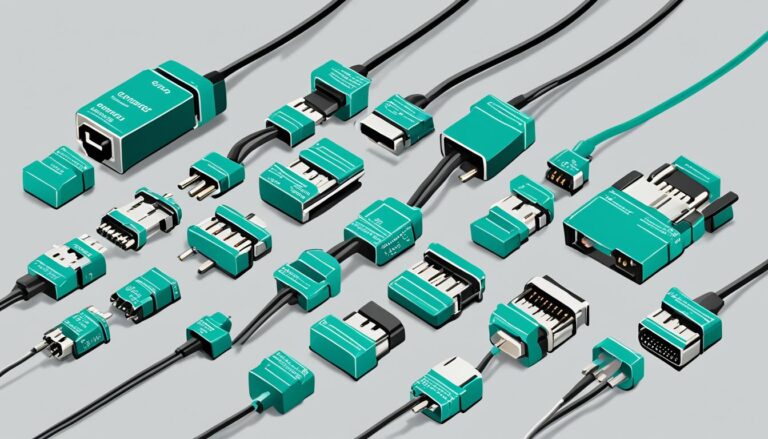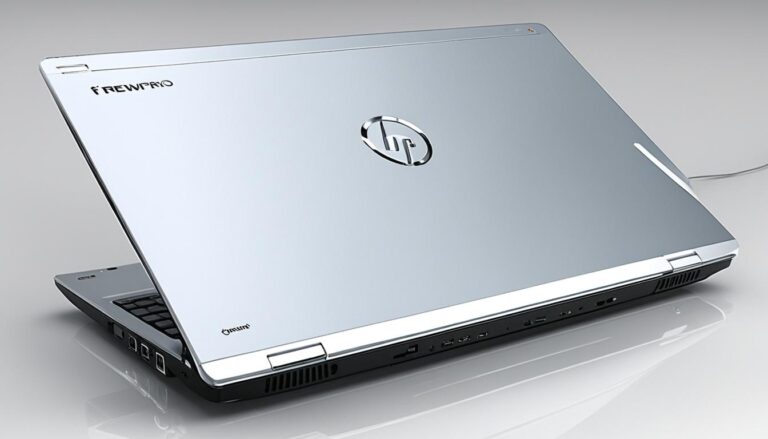We have many choices for connecting monitors to our gadgets. Each monitor plug, like VGA, DVI, DisplayPort, HDMI, and USB Type-C, has its own perks. This guide will help you figure out which plug fits your needs best.
Starting with VGA (Video Graphics Array), it’s the old standard but was a key player for video gear. Then, there’s DVI (Digital Visual Interface), which beats VGA by offering clearer images. It’s still seen on many desktops and screens.
HDMI (High Definition Multimedia Interface) is now the go-to choice. It handles both video and audio, beloved by movies, tech, and gaming industries. Then, DisplayPort steps in with top-notch graphics and speed for gaming and editing.
Not to forget, USB Type-C does it all – video, audio, data, and power. It’s the new kid, fitting perfectly with modern tech. It’s reversible, replacing older ports to connect devices seamlessly.
With these options, choosing the right plug depends on your needs. Be it for work, games, or study, each plug has something special. Now, picking the best match for you is easier.
Continue reading to explore HDMI, DVI, DisplayPort, and USB Type-C in more detail.
Understanding HDMI as a Monitor Plug
HDMI (High Definition Multimedia Interface) is the most common monitor plug today. It’s the top pick for film companies, tech makers, and video game industries. HDMI shines because it carries top-notch video and audio signals. This makes it perfect for a range of gadgets and needs.
There are four different types of HDMI cables. Each one serves different resolution and performance needs:
| HDMI Cable Types | Resolution Support |
|---|---|
| HDMI Standard | Up to 1080p |
| HDMI High Speed | Up to 4K resolution |
| HDMI Premium High Speed | For HDR-enabled devices |
| HDMI Ultra High Speed | Uncompressed 8K video display |
The HDMI Standard cable is great for daily use, handling up to 1080p. The HDMI High Speed cable is for 4K displays, giving brilliant visuals. If you’re into HDR content, the HDMI Premium High Speed cable is your go-to. It gives the bandwidth for better colour and contrast. The HDMI Ultra High Speed cable is for 8K video, perfect for pros.
HDMI leads the market in compatibility and ease, making it the favourite monitor plug for many.
Exploring DVI as a Monitor Plug
DVI (Digital Visual Interface) serves as a versatile plug for monitors, carrying both digital and analog signals. Compared to HDMI, it gives a better frame rate and clearer image for 1080p screens. We’ll examine DVI cables, including single-link and dual-link types, and their resolution capabilities.
The Two Types of DVI Cables
There are two kinds of DVI cables: single-link DVI and dual-link DVI. They’re designed for different uses and offer various resolution supports.
“DVI cables come in two different types, single-link DVI and dual-link DVI.”
Single-link DVI cables, the more common variety, support up to 1920 x 1200 resolution. This makes them great for many computer monitors and HD displays.
“Single-link DVI cables support resolutions up to 1920 x 1200.”
Dual-link DVI cables, meanwhile, support higher resolutions. They can handle up to 2560 x 1600, perfect for top-notch monitors and graphics workstations.
“Dual-link DVI cables can handle resolutions up to 2560 x 1600.”
DVI Resolution Support
DVI cables outdo HDMI when it comes to resolution support. They are the go-to for those needing higher resolution displays.
With single-link DVI cables, you can get up to 1920 x 1200 resolution. This is adequate for most HD screens and computer displays.
“Single-link DVI cables support resolutions up to 1920 x 1200.”
Dual-link DVI cables push the limit to 2560 x 1600 resolution. This is essential for tasks needing detailed graphics and precise colors.
“Dual-link DVI cables can support resolutions up to 2560 x 1600.”
DVI Cables and Video Cards
DVI connections are available on both budget and high-end video cards. This makes them a versatile option for different budgets.
With a video card that has DVI outputs, connecting to a DVI-compatible monitor is easy. This setup guarantees a stellar visual quality.
Understanding DisplayPort as a Monitor Plug
DisplayPort is a modern connection found mainly on high-end monitors. It boosts performance. You get higher resolutions and quicker refresh rates than HDMI. Gamers, video editors, and people who do heavy visual work love it.
There are three main types of DisplayPort cables: DisplayPort 1.2, DisplayPort 1.3, and DisplayPort 1.4. Each update brings new features and better experiences. They give users more options and improved visuals.
DisplayPort 1.2 is the most common version. You’ll see it often. It supports resolutions up to 3840 x 2160, good for HD content. This version also lets you connect many monitors with just one cable.
DisplayPort 1.3 takes things further, with 8K video support at 30 Hz. The visuals are incredibly sharp and detailed. It also has HDR video support, which makes colors more vibrant and contrast better. This makes what you see more lifelike.
DisplayPort 1.4 is the newest version. It does 8K videos at 60 Hz for super smooth content. It continues the HDR support and adds Display Stream Compression (DSC). This means even better resolutions and color depths.
When picking a DisplayPort cable, choose based on your needs. DisplayPort 1.2 cables are easy to find and great for everyday tasks. For higher resolutions or HDR, go for DisplayPort 1.3 or 1.4 cables. They’ll upgrade your viewing dramatically.
The Versatility of USB Type-C as a Monitor Plug
USB Type-C, also known as USB-C, is a monitor plug with many uses. It is popular for connecting laptops and mobile devices to monitors. USB Type-C can send video, audio, data, and power all at once. This makes it a handy all-in-one solution.
Many new monitors and laptops have USB Type-C ports. They are made to be flexible and ready for the future. One great feature of USB Type-C is that you can plug it in any way around. You don’t have to worry about which way is up. This design is user-friendly and stops the hassle of traditional ports.
USB Type-C can also take the place of other monitor plugs like DisplayPort or HDMI. This means you can use adapters to connect devices with USB Type-C to monitors that have DisplayPort or HDMI. There are many USB-C accessories available. These include USB-C to HDMI adapters and docking station cable locks.
USB Type-C is perfect whether you’re working on detailed graphics, gaming, or just want ease and flexibility. Its ability to work with many devices and accessories makes it a top choice for modern monitor connections.
FAQ
What are the different types of monitor plugs and their uses?
There are many monitor plugs, including VGA, DVI, HDMI, DisplayPort, and USB Type-C. VGA is quite old but is still used for some video cards and monitors. DVI gives a clearer picture and is found on various desktops and LCDs.
HDMI is very popular and can carry video and audio together. DisplayPort is seen on high-end graphics cards and supports top-quality resolutions and refresh rates. USB Type-C is a modern port that handles video, audio, data, and power efficiently.
What are the different types of HDMI cables and their uses?
HDMI cables come in four types:
– HDMI Standard for up to 1080p resolution.
– HDMI High Speed for 4K.
– HDMI Premium High Speed for HDR devices.
– HDMI Ultra High Speed for 8K.
HDMI is key for movie companies, tech makers, and video game producers.
What are the different types of DVI cables and their resolutions?
DVI cables are of two kinds:
– Single-link DVI goes up to 1920 x 1200 resolution.
– Dual-link DVI reaches 2560 x 1600. DVI is seen in both budget and high-end video cards.
What are the different types of DisplayPort cables?
DisplayPort cables vary too:
– DisplayPort 1.2 for up to 3840 x 2160 resolution.
– DisplayPort 1.3 for 8K at 30 Hz.
– DisplayPort 1.4 for 8K at 60 Hz and HDR.
DisplayPort is perfect for gaming, video editing, and tasks needing high-quality visuals.
What is the functionality of USB Type-C as a monitor plug?
USB Type-C is multifunctional. It sends video, audio, data, and power. You’ll find it on adaptable monitors and laptops. It’s easy to use because it’s reversible and can take over for DisplayPort or HDMI.
There’s a range of USB-C gear like adapters to HDMI, DisplayPort adapters, multi-port hubs, and locking cables for docks. USB-C is preferred for hooking up laptops and mobile gear to displays.
